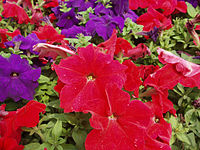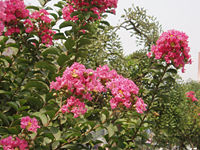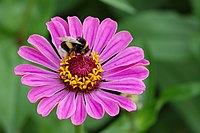Bloom Clock/Keys/Global/Temperate/Early Fall/Red Flowers

This page is part of the global dichotomous key for plants recorded as blooming in Early Fall.
These plants have the following traits:
- Red flowers
Chrysanthemum x morifolium
 Wikipedia • Commons • Wikibooks (horticulture) • Wikibooks (subject) • Wikispecies • Fruit and seed clock |
Profile for Chrysanthemum x morifolium (Hardy Chrysanthemum, Mum)
Recent Logs[edit | edit source] | ||
Global data:
Temperate zone season(s): Mid Fall, Late Fall, Early Winter
Vinca minor
 Wikipedia • Commons • Wikibooks (horticulture) • Wikibooks (subject) • Wikispecies • Fruit and seed clock |
Profile for Vinca minor (Periwinkle)
Recent Logs[edit | edit source]
| ||||||||||
Global data:
Temperate zone season(s): Early Winter, Mid Winter, Early Spring, Mid Spring, Late Spring, Early Summer, Early Fall, Mid Fall, Late Fall
Viola x wittrockiana
 Wikipedia • Commons • Wikibooks (horticulture) • Wikibooks (subject) • Wikispecies • Fruit and seed clock |
Profile for Viola x wittrockiana (Pansy)
Recent Logs[edit | edit source]
| ||||||
Global data:
Temperate zone season(s): Early Spring, Mid Spring, Mid Summer, Early Fall, Mid Fall, Late Fall, Early Winter
Phlox paniculata
 Wikipedia • Commons • Wikibooks (horticulture) • Wikibooks (subject) • Wikispecies • Fruit and seed clock |
Profile for Phlox paniculata (Garden Phlox)
Recent Logs[edit | edit source] | ||||||||||||
Global data:
Temperate zone season(s): Early Summer, Mid Summer, Late Summer, Early Fall, Mid Fall, Late Fall, Early Winter
Lonicera x heckrottii
 Wikipedia • Commons • Wikibooks (horticulture) • Wikibooks (subject) • Wikispecies • Fruit and seed clock |
Profile for Lonicera x heckrottii (Flame Honeysuckle)
Recent Logs[edit | edit source] | ||||||||||||||
Global data:
Temperate zone season(s): Mid Winter, Mid Spring, Late Spring, Early Summer, Mid Summer, Late Summer, Early Fall, Mid Fall, Late Fall, Early Winter
Tagetes patula
 Wikipedia • Commons • Wikibooks (horticulture) • Wikibooks (subject) • Wikispecies • Fruit and seed clock |
Profile for Tagetes patula (French Marigold)
Recent Logs[edit | edit source]
| ||
Global data:
Begonia
 Wikipedia • Commons • Wikibooks (horticulture) • Wikibooks (subject) • Wikispecies • Fruit and seed clock |
Profile for Begonia (Begonia)
Recent Logs[edit | edit source]
| ||
Global data:
Temperate zone season(s): Early Summer, Mid Summer, Mid Fall, Late Fall
Hesperis matronalis
 Wikipedia • Commons • Wikibooks (horticulture) • Wikibooks (subject) • Wikispecies • Fruit and seed clock |
Profile for Hesperis matronalis (Dame's Rocket)
Recent Logs[edit | edit source]
| ||||||||
Global data:
Temperate zone season(s): Late Spring, Early Summer, Late Summer, Mid Fall
Salvia splendens
 Wikipedia • Commons • Wikibooks (horticulture) • Wikibooks (subject) • Wikispecies • Fruit and seed clock |
Profile for Salvia splendens (Scarlet Sage)
Recent Logs[edit | edit source] | ||
Global data:
Petunia x hybrida
 Wikipedia • Commons • Wikibooks (horticulture) • Wikibooks (subject) • Wikispecies • Fruit and seed clock |
Profile for Petunia x hybrida (Petunia)
Recent Logs[edit | edit source]
| ||
Global data:
Rosa 'Knockout'
 Wikipedia • Commons • Wikibooks (horticulture) • Wikibooks (subject) • Wikispecies • Fruit and seed clock |
Profile for Rosa 'Knockout' (Knockout Rose)
Recent Logs[edit | edit source]
| ||
Global data:
Temperate zone season(s): Early Summer, Mid Summer, Mid Fall, Late Fall
Impatiens walleriana
 Wikipedia • Commons • Wikibooks (horticulture) • Wikibooks (subject) • Wikispecies • Fruit and seed clock |
Profile for Impatiens walleriana (Busy-lizzie, Impatiens)
Recent Logs[edit | edit source]
| ||
Global data:
Celosia argentea
 Wikipedia • Commons • Wikibooks (horticulture) • Wikibooks (subject) • Wikispecies • Fruit and seed clock |
Profile for Celosia argentea (Cock's Comb)
Recent Logs[edit | edit source] | ||
Global data:
Lagerstroemia indica
 Wikipedia • Commons • Wikibooks (horticulture) • Wikibooks (subject) • Wikispecies • Fruit and seed clock |
Profile for Lagerstroemia indica (Crape Myrtle)
Recent Logs[edit | edit source]
| ||||||||||
Global data:
Temperate zone season(s): Mid Summer, Late Summer, Early Fall, Mid Fall
Amaranthus caudatus
 Wikipedia • Commons • Wikibooks (horticulture) • Wikibooks (subject) • Wikispecies • Fruit and seed clock |
Profile for Amaranthus caudatus (Love lies bleeding)
Recent Logs[edit | edit source] | ||
Global data:
Rosa
 Wikipedia • Commons • Wikibooks (horticulture) • Wikibooks (subject) • Wikispecies • Fruit and seed clock |
Profile for Rosa (Rose)
Recent Logs[edit | edit source]
| ||||||||||||||
Global data:
Temperate zone season(s): Late Spring, Early Summer, Mid Summer, Late Summer, Early Fall Mid Fall, Late Fall
Pentas lanceolata
 Wikipedia • Commons • Wikibooks (horticulture) • Wikibooks (subject) • Wikispecies • Fruit and seed clock |
Profile for Pentas lanceolata (Pentas)
This page contains recent bloom logs for the plant Pentas lanceolata (Pentas). If you saw this plant blooming today (or sometime within the last 3 days), you can help improve the bloom clock by logging it. Just click on "edit" next to the Recent Logs heading, add *~~~~ (an asterisk followed by four tildes) on a new line just below the last signature, and then click "save page". This will add your signature and the date to log the plant. Please make sure you've signed up on the contributors' page so that we can know the location of the plant you saw blooming and use your contribution to create a flora for your region! When you're done, you can go back to one of the main pages and find logs of other flowers you might have seen today.
Recent Logs[edit | edit source]Archived Logs[edit | edit source](If there are more than 5 signatures under the recent logs heading, move the oldest logs to under this heading (generally leave the 3 most recent).
| ||
Global data:
Zinnia violacea
 Wikipedia • Commons • Wikibooks (horticulture) • Wikibooks (subject) • Wikispecies • Fruit and seed clock |
Profile for Zinnia violacea (Zinnia)
Recent Logs[edit | edit source] | ||
Global data:
Hibiscus syriacus
 Wikipedia • Commons • Wikibooks (horticulture) • Wikibooks (subject) • Wikispecies • Fruit and seed clock |
Profile for Hibiscus syriacus (Garden Hibiscus)
Recent Logs[edit | edit source]
| ||||||||
Global data:
Lobelia cardinalis
 Wikipedia • Commons • Wikibooks (horticulture) • Wikibooks (subject) • Wikispecies • Fruit and seed clock |
Profile for Lobelia cardinalis (Cardinal Flower)
Recent Logs[edit | edit source] | ||
Global data:
Hemerocallis
 Wikipedia • Commons • Wikibooks (horticulture) • Wikibooks (subject) • Wikispecies • Fruit and seed clock |
Profile for Hemerocallis (Daylily)
Recent Logs[edit | edit source]
| ||||||||||
Global data:
Temperate zone season(s): Early Summer, Mid Summer, Late Summer, Early Fall
Dahlia
 Wikipedia • Commons • Wikibooks (horticulture) • Wikibooks (subject) • Wikispecies • Fruit and seed clock |
Profile for Dahlia (Dahlia)
Recent Logs[edit | edit source]
| ||
Global data:
Salvia vanhouttei
 Wikipedia • Commons • Wikibooks (horticulture) • Wikibooks (subject) • Wikispecies • Fruit and seed clock |
Profile for Salvia vanhouttei (Salvia)
Recent Logs[edit | edit source]
| ||||||||||||||
Global data:

